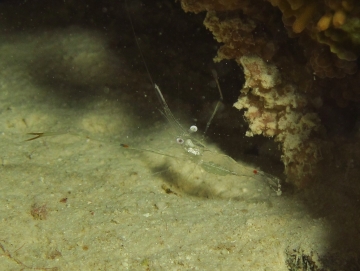700623_Hidden Eyes_360 px width.jpg

Some creatures, like this transparent shrimp (look closely!), are at risk of being spotted due to pigments in their eyes. Researchers have found a very thin coating made up of tiny spheres in their eyes that can reflect light to help them blend into their surroundings. Credit: MDC Seamarc Maldives, CC BY-SA 4.0.
In the human world, having “bright eyes” is considered a good thing. It means you’re alert, curious, or energetic—a bright personality with a bright outlook. But in the marine world, bright eyes can be deadly. A critter with bright eyes is easier for predators and prey to spot. That makes it more likely to get eaten, and less likely to catch its own meals.
Some marine creatures have developed a way to hide those bright eyes. A thin glass coating bends and reflects light in a way that allows the eyes to blend into the background.
Researchers discovered the coating by using a special type of electron microscope to study the eyes of young shrimp, crabs, and lobsters. These creatures have almost transparent bodies, so they’re hard to see. But their eyes can give them away—they’re like tiny spotlights.
To darken the spotlights, the eyes have a glass coating that’s a few millionths of an inch thick. It consists of tiny plates that stick together to form balls. The location and concentration of the balls can change depending on the lighting conditions. They reflect the light from the environment, so the color of the eye matches the surroundings—ranging from yellowish to deep blue. Tiny gaps between the balls allow light to reach the retina, so the creatures can see what’s going on around them.
Further studies of these eyes could lead to more efficient solar cells, or new paints that are better for the environment—bright developments from hidden eyes.

